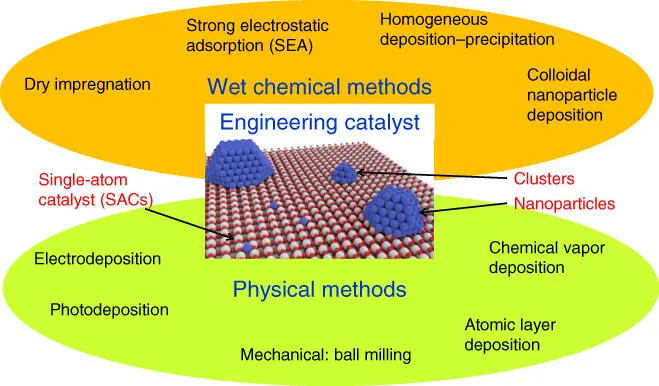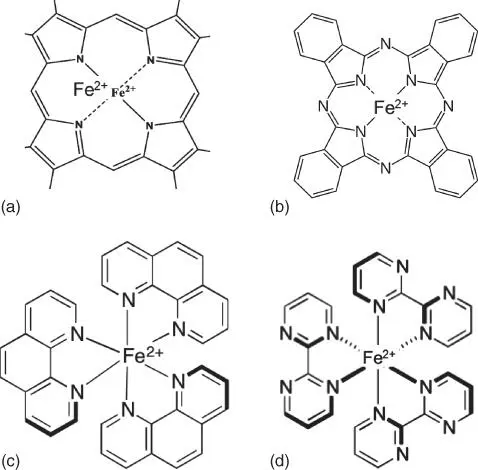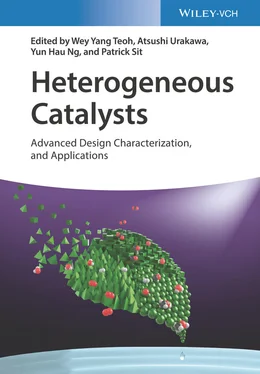
Figure 4.5 Relevant techniques optimized to prepare engineered catalysts on carbon materials.
4.3.1 Deposition of Colloidal Nanoparticles
Recent advances in colloidal synthesis have enabled preparing monometallic or bimetallic nanoparticles (e.g. alloys, core–shell structures) with well‐defined structures and sizes. These nanocrystals have ligands or capping agents that need to be removed prior to catalysis to increase the activity, although in some cases the ligands can be reaction promoters when chosen judiciously. In general, the two main challenges to prepare an efficient and practical catalyst from colloidal nanoparticles are: (i) to uniformly disperse the nanoparticles on a support and (ii) the subsequent activation by the removal of the ligand using thermal treatment or mild oxidation. Carbon supports such as CNT or graphene are ideal supports to deposit preformed nanoparticles since the absence of microporosity and open porosity favors the infiltration of the nanoparticles to all the deep surfaces of the carbon material. To disperse the nanocrystals uniformly on a carbon support, the particle–support and particle–particle interactions should be balanced. If the interaction of the particles between themselves is stronger than with the support, the particles will tend to aggregate. The amount of ligand and the temperature can tune the strength of interactions of the nanoparticles with the support as demonstrated in the assembly of Fe nanocrystals on CNT [42]. To develop an active catalyst and make the metal accessible to reactants, the capping agent must be removed by thermal treatment or mild oxidation. The problem is that in this step, the nanoparticles may begin to coalesce. Therefore, the particles can change their size and shape if the oxidation step is severe. Therefore, the ligand should be removed under milder conditions as possible. In principle, stabilization should be achieved more easily on a carbon material with a higher amount of defects and oxygenated surface groups than on undefective graphitic carbon materials because the former has more anchoring sites for the nanoparticles after removing the capping agent. The removal of ligands is even more difficult for transition metals than for noble metal nanocrystals since the ligands usually bind stronger to the former.
4.3.2 Single‐Metal Atom Deposition by Wet Chemistry
Carbons doped with heteroatoms (e.g. N, B, P, S) have the ability to coordinate transition‐metal atoms and thereby stabilizing them as single‐site catalyst. To prepare single‐atom sites, loading of metal deposits on the heteroatom‐doped carbon substrate can be carried out using traditional wet impregnation, followed by acid leaching to remove nanoparticles and noncoordinated metal atoms. This leaves behind the strongly bound single metal atoms, each coordinated by the surrounding heteroatom dopants. In particular, the strong interaction between N‐dopant and metals has been verified theoretically and experimentally using techniques X‐ray photoelectron spectroscopy (XPS), near edge X‐ray absorption fine structure (NEXAFS) [43], and transmission electron microscopy (TEM)–electron energy loss spectroscopy (EELS) [44]. The interaction is enabled by the delocalized free electrons of N on carbon. Their origins in turn can be explained by the electron back‐donation, where the σ ‐type electron from the filled orbital of the N atom is donated to the empty orbital of the metal atom, leading to a π back‐donation from filled metal atomic orbital to the antibonding orbital of the N atom.
4.3.3 Immobilization of Metal Clusters and SACs by Organometallic Approach
Mixed‐metal clusters modified with appropriate ligands can be immobilized onto CNTs and graphene using covalent or noncovalent π–π interactions [45] (see Chapter 5on metal clusters synthesis). Subsequent removal of the stabilizing ligand by thermal treatment may lead to a different extent of coalescence, which depending on the exposed temperatures can result in carbon‐supported nanoparticles.
When the preparation of SACs on carbon is sought, an interesting approach is to use organometallic precursors containing both the dopant element such as nitrogen and the metal. Macrocyclic complexes bearing transition‐metal atoms similar to porphyrins, which contain both the dopant element and the metal, are excellent precursors to CUS or SACs. These macrocycles are noncovalently bound on graphitic materials by π–π stacking. The covalent anchoring of these macrocycles on carbon lattice upon pyrolysis is favored by the affinity of nitrogen atom for carbon materials. This will pave the way for stabilizing the catalyst under different solvents and under severe reaction conditions. Several macrocyclic molecules containing both metal and nitrogen atoms such as iron porphyrin or macrocycles formed by mixing phenanthroline or 2,2‐bipyridine and Fe salt have been used to prepare atomically dispersed Fe–N xspecies on different carbon materials. Figure 4.6shows some macrocycles used as precursors of single‐atom metal–N xspecies on carbon materials. The special ligand endows the metal with the electronic density necessary to perform a reaction selectively suppressing undesired collateral reactions. The catalysts prepared have shown high activity in ORR comparable to Pt catalyst with high selectivity in the four‐electron reduction.

Figure 4.7 Different precursors to prepare nitrogen‐coordinated SACs. (a) Iron porphyrin, (b) iron phthalocyanine, (c) phenanthroline + Fe salt, and (d) 2,2‐bipyridine + Fe salt.
4.3.4 Chemical Vapor Deposition Techniques on Carbon Supports
CVD of organometallic precursors under oxidative conditions is a conventional technique for the deposition of nanoparticles on supports. Recently, atomic‐layer deposition (ALD) has emerged as a particular case of CVD. In contrast to conventional CVD, precursors are introduced as a series of sequential and nonoverlapping pulses. In each of these pulses, the precursor molecules react with the surface and the reaction ends once all the reactive sites on the surface are utilized. Therefore, the amount of material deposited depends on the precursor–surface interaction and the number of ALD cycles.
The ALD on pristine carbon supports such as graphene can be hampered by the limited interactions associated with basal planes, and ALD is only able to deposit material on defects and edges. Moreover, noble metal ALD on graphene is reported to lead to the formation of a mixture of atoms, clusters, and nanoparticles of Pt. Accordingly, in order to deposit single‐atom metal sites on graphene by ALD, a previous step of functionalization with oxygenated groups is necessary. Only recently, ALD has been used to prepare single‐atom Pt site on graphene functionalized with oxygen reactive sites [46]. By repeating the number of ALD cycles (exposure to metal precursor – O 2), it is possible to go from single atoms to clusters of controlled size.
4.3.5 Simultaneous Formation of Metallic Catalyst and Porous Carbon Support by Pyrolysis
The loading of SACs by wet chemistry methods depends greatly on the density of anchoring sites on the support, and it is usually low. To circumvent the limitation, pyrolysis (i.e. treatment at high temperatures under inert gas) of molecularly defined porous structures containing both the source of metal and carbon can lead to higher loadings. In fact, it would be interesting if the porous structure is retained in the final carbon material. Otherwise, a sacrificial template can be used to preserve the porosity upon pyrolysis. Metal–organic frameworks (MOFs; see Chapter 8for more details), composed of periodic and porous networks of organic linkers with metal atom centers, are an excellent platform to prepare single‐site catalysts on porous carbon in one‐step pyrolysis. This approach has been used to attain transition‐metal single sites on nitrogen‐doped carbon [47].
Читать дальше



